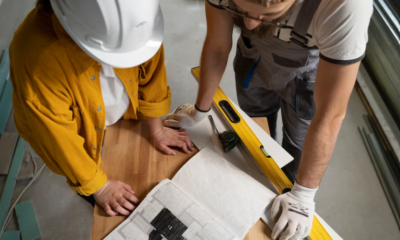BUSINESS
The Crucial Role of a Home Inspector in Jacksonville Real Estate Transactions
Home inspection is one of the most important steps when buying or selling a property in Jacksonville, Florida. A Home Inspector in Jacksonville plays a vital role in ensuring buyers and sellers understand the property’s condition. But what exactly does a home inspector do, and why is their role so crucial in real estate transactions? Let’s dive into the world of home inspections and explore how these professionals can make or break a deal.
What is a Home Inspector?
Before we delve into the specifics, let’s start with the basics. A home inspector is a trained professional who evaluates a property’s condition. They examine various aspects of the house, from the foundation to the roof and everything in between. Their job is to provide an unbiased, detailed report on the property’s current state, highlighting any issues or potential problems that may need attention.
The Qualifications of a Home Inspector
Now, you might be wondering, “Can just anyone become a home inspector?” Well, not exactly. In Florida, home inspectors need to be licensed by the state. This involves:
- Completing a state-approved course
- Passing a written exam
- Obtaining liability insurance
- Completing continuing education to maintain their license
These requirements ensure that when you hire a home inspector in Jacksonville, you’re getting a qualified professional who knows what they’re doing.
The Home Inspection Process: What to Expect
So, you’ve decided to get a home inspection. Great choice! But what exactly happens during this process? Let’s break it down step by step.
Scheduling the Inspection
Typically, the buyer’s real estate agent will schedule the inspection after the offer has been accepted. The inspection usually takes place within a week or two of the offer acceptance.
Duration of the Inspection
A thorough home inspection can take anywhere from 2 to 4 hours, depending on the size and condition of the property. It’s a good idea for the buyer to be present during the inspection, as this allows for direct communication with the inspector and the opportunity to ask questions on the spot.
Areas Covered in the Inspection
A home inspector in Jacksonville will examine various components of the property, including:
- Structural elements (foundation, walls, roof)
- Exterior Features (siding, grading, drainage)
- Roof and attic
- Plumbing systems
- Electrical systems
- Heating, ventilation, and air conditioning (HVAC) systems
- Interior elements (floors, walls, ceilings, windows, doors)
- Insulation and ventilation
- Fireplaces and chimneys
- Garages and carports
The Inspection Report
After the inspection, the home inspector will provide a detailed written report, usually within 24 to 48 hours. This report will outline their findings, including any defects or areas of concern they’ve identified.
Understanding the Implications of Various Findings
Now that we know what a home inspector looks for, let’s discuss what their findings might mean for you as a buyer or seller.
Minor Issues
Some findings are minor and easy to fix. These could include:
- Loose doorknobs or cabinet handles
- Minor plumbing leaks
- Worn weatherstripping
- Peeling paint
While these issues shouldn’t be ignored, they’re usually not deal-breakers and can often be easily addressed.
Moderate Concerns
Other findings might be more significant but still manageable. These could include:
- Outdated electrical panels
- Aging HVAC systems
- Signs of past water damage
- Minor foundation cracks
These issues require more substantial repairs or replacements, which could impact negotiations between the buyer and seller.
Major Red Flags
Some findings can be serious enough to make a buyer reconsider their purchase. These might include:
- Significant structural issues
- Active water intrusion
- Extensive mold growth
- Major electrical or plumbing problems
- Severe pest infestations
These issues can be costly to repair and may pose safety risks. In such cases, buyers might choose to walk away from the deal or request significant concessions from the seller.
The Impact of Home Inspections on Real Estate Transactions
Home inspections can have a significant impact on real estate transactions in Jacksonville. Let’s explore how they can affect both buyers and sellers.
For Buyers
As a buyer, a home inspection gives you valuable information about the property you’re considering purchasing. It can:
- Help you make an informed decision about whether to proceed with the purchase
- Provide leverage for negotiations if significant issues are found
- Give you an idea of future maintenance and repair costs
- Identify safety concerns that need to be addressed
- Offer peace of mind about your investment
For Sellers
If you’re selling your home, a pre-listing inspection can be beneficial. It allows you to:
- Identify and address issues before putting your home on the market
- Set a fair and competitive price based on the actual condition of your home
- Avoid surprises and potential deal-breakers during buyer inspections
- Demonstrate transparency and build trust with potential buyers
Common Misconceptions About Home Inspections
There are a few misconceptions about home inspections that are worth addressing:
Myth 1: A Home Inspection is the same as an Appraisal
While both are important in the home-buying process, they serve different purposes. An appraisal determines the value of the property, while a home inspection assesses its condition.
Myth 2: New Homes Don’t Need Inspections
Even newly constructed homes can have issues. A home inspection can identify construction defects or oversights that need to be addressed.
Myth 3: Home Inspectors Will Pass or Fail a House
Home inspectors don’t “pass” or “fail” houses. They provide an objective assessment of the property’s condition, leaving it to the buyer and seller to decide how to proceed based on the findings.
Myth 4: Home Inspectors Can See Through Walls
While home inspectors are thorough, they’re not superheroes. They can only inspect what’s visible and accessible. They can’t see inside walls or under concrete slabs.
The Importance of a Home Inspector in Jacksonville’s Unique Climate
Jacksonville’s subtropical climate presents unique challenges for homeowners and, consequently, for home inspectors. Let’s explore some of the specific areas that a Jacksonville home inspector might pay extra attention to due to the local climate.
Moisture and Mold Issues
Jacksonville’s high humidity levels can lead to moisture problems in homes. A skilled home inspector will look for signs of:
- Mold growth, especially in basements, attics, and crawl spaces
- Water stains on ceilings or walls
- Musty odors that could indicate hidden moisture problems
- Proper ventilation in bathrooms and kitchens to prevent moisture buildup
Hurricane Preparedness
Given Jacksonville’s vulnerability to hurricanes, a home inspector will assess:
- The condition of the roof and its ability to withstand high winds
- The presence and condition of storm shutters or impact-resistant windows
- Proper drainage systems to prevent flooding
- The structural integrity of the home to withstand severe weather
Pest Inspections
Jacksonville’s warm, moist climate is ideal for various pests. While not all home inspectors are licensed pest inspectors, many will look for signs of:
- Termite damage or active infestations
- Other wood-destroying organisms like powder post beetles or wood-boring beetles
- Rodent infestations
- Evidence of other pest problems
HVAC Systems
Given Jacksonville’s hot summers, a properly functioning air conditioning system is crucial. The home inspector will:
- Check the age and condition of the HVAC system
- Ensure the system is adequately sized for the home
- Look for signs of proper maintenance
- Check for energy efficiency, which can significantly impact utility costs in Jacksonville’s climate
How to Choose the Right Home Inspector in Jacksonville
Selecting the right home inspector is crucial to ensuring you get an accurate and thorough assessment of the property. Here are some tips for choosing a home inspector in Jacksonville:
- Check for proper licensing and certifications
- Look for inspectors with experience in Jacksonville’s specific climate and building styles
- Ask for sample reports to get an idea of how detailed and clear their inspections are
- Read reviews and ask for references from past clients
- Ensure they carry errors and omissions insurance
- Look for membership in professional organizations like the International Association of Certified Home Inspectors (InterNACHI) or the American Society of Home Inspectors (ASHI)
The Future of Home Inspections in Jacksonville
As technology advances, so does the field of home inspections. Here are some trends we might see in the future of home inspections in Jacksonville:
Drone Inspections
Drones are increasingly being used to inspect roofs and other hard-to-reach areas. This technology allows for safer and more thorough inspections of these crucial components.
Thermal Imaging
Infrared cameras can detect temperature differences that might indicate insulation problems, moisture issues, or electrical hotspots. This technology is becoming more common in home inspections.
Digital Reports with Video
Future inspection reports might include video walkthroughs instead of static images, allowing buyers to revisit the inspection findings in more detail.
Smart Home System Inspections
As more homes incorporate smart technology, home inspectors may need to expand their expertise to evaluate these systems properly.
Conclusion: The Invaluable Role of Home Inspectors in Jacksonville Real Estate
In conclusion, a home inspector plays a crucial role in Jacksonville real estate transactions. They provide an unbiased, professional assessment of a property’s condition, helping both buyers and sellers make informed decisions.
For buyers, a home inspection can reveal potential issues that might not be apparent during a casual walkthrough, saving thousands of dollars in future repairs. It also provides peace of mind, ensuring that their significant investment is sound.
For sellers, a pre-listing inspection can help identify and address issues before they become sticking points in negotiations. It can also demonstrate transparency and build trust with potential buyers.
In Jacksonville’s unique climate, with its high humidity, hurricane risks, and pest concerns, a thorough home inspection is particularly crucial. It can uncover climate-specific issues that might be overlooked in other regions.
Remember, while a home inspection is an additional expense in the home-buying process, it’s an investment in your future. The cost of an inspection is minimal compared to the potential costs of undiscovered issues down the line.
Whether you’re buying or selling a home in Jacksonville, don’t underestimate the value of a professional home inspection. It’s not just a step in the process—it’s a vital tool for making one of the most significant financial decisions of your life. Choose your inspector wisely, be present for the inspection if possible, and don’t hesitate to ask questions. After all, knowledge is power, especially in real estate transactions.
BUSINESS
How Often Should You Visit the Dentist? Insurance-Friendly Tips

General Recommendations for Dental Visits
How often you need to visit the dentist isn’t always clear-cut. The long-standing rule was to see your dentist two times a year for checkups and professional cleanings. This twice-yearly schedule promotes early detection of dental concerns, such as tooth decay, gum disease, and oral cancer, making treatment easier and less invasive. By catching problems before they can worsen, you can often avoid more complex and expensive procedures.
For those with chronic conditions, such as diabetes, or a past incidence of cavities and gum disease, dental professionals often suggest more frequent check-ins, sometimes every three to six months. This shorter interval allows your dentist to closely monitor healing, disease progression, and the effectiveness of your home care routine. Many dental insurance policies, especially comprehensive options like Delta Dental PPO insurance in Florida, are designed to support regular preventive care, making it easier to stick to the right schedule without unexpected costs. If you’re unsure how often you should go, talk with your dentist about individual risk factors and how other health issues, such as pregnancy or medication use, may influence your needs.
Factors Influencing Visit Frequency
Your unique health profile determines how often dental appointments should be booked. Consider these influencing elements:
- Oral Health Status: Past or current dental problems, such as recurring tooth decay, enamel erosion, or gum disease, require closer monitoring. Some patients are more prone to cavities or periodontal disease due to genetic factors, medications, or underlying medical conditions.
- Overall Health: Illnesses like heart disease and autoimmune conditions may necessitate more frequent dental oversight. Evidence shows a strong connection between oral and systemic health; conditions like diabetes can influence gum health, so regular dental evaluations are essential.
- Lifestyle Choices: Smoking, high sugar intake, and poor oral hygiene increase the risk of issues and warrant more regular exams. If you suffer from dry mouth due to medications or treatment (like radiation therapy), you may also be at higher risk for oral health problems.
For those at low risk, which means you practice good oral hygiene, have no history of dental disease, and maintain a balanced diet, annual or twice-yearly visits may suffice. Always consult your dentist to determine an individualized care plan based on these factors, and don’t hesitate to ask about what schedule best fits your life and health status.
Maximizing Dental Insurance Benefits
Dentists urge patients to make the most of their dental insurance coverage, which can significantly impact treatment decisions and costs. Many often leave benefits unused, potentially missing out on essential preventive care that their plan covers. Here are effective ways to maximize your benefits:
- Stay In-Network: Choose a provider within your insurance’s network for lower co-pays, as insurers have pre-negotiated rates with participating dentists. Out-of-network care often means higher out-of-pocket costs, so consult your insurance portal to find a suitable dentist.
- Strategic Treatment Planning: If you need extensive dental work, consider spreading treatments over the end and beginning of two calendar years to take advantage of annual benefit resets. By doing this, you may be able to use two years’ worth of benefits to cover procedures, reducing your expenses.
- Utilize Tax-Advantaged Accounts: Flexible Spending Accounts (FSAs) and Health Savings Accounts (HSAs) can be used to pay for eligible dental expenses with pre-tax dollars; track deadlines to avoid losing unused funds. These accounts are especially valuable if your plan limits covered treatments or you need elective procedures.
Review your insurance benefits annually and discuss with your dentist to optimize preventive and necessary care. Many dentists will even help you navigate paperwork to ensure your treatment is as affordable as possible, so don’t hesitate to ask their office staff for guidance.
Preventive Care: A Cost-Effective Approach
Preventive dentistry is your best defense against high dental costs and health problems. Regular dental cleanings and examinations can help catch cavities, gum problems, and oral cancers before they progress. Early detection leads to simpler, less invasive, and less expensive treatments. Most dental plans cover these visits at 100%, making them the most cost-effective way to maintain oral health. Even if you’re paying out of pocket, prevention is much lower than the cost of treating problems left to worsen over time.
Preventive Services Often Covered
- Professional cleanings to remove hardened plaque and tartar that brushing alone can’t reach
- Examinations and X-rays to reveal hidden cavities or bone loss that may be missed during a visual inspection
- Sealants and fluoride treatments for children, and sometimes for adults at greater risk for cavities, to strengthen tooth enamel and prevent decay
Routine dental care can prevent costly interventions and more serious health issues later. Untreated gum disease, for instance, has been linked to heart disease, stroke, and complications during pregnancy, making prevention invaluable to your overall well-being.
Addressing Dental Anxiety
Anxiety about dental visits is common, but avoiding the dentist only increases the risk of serious issues. Millions of Americans delay or skip dental care due to fear, but modern dental practices offer solutions to make visits more comfortable and stress-free. By addressing dental anxiety head-on, you protect yourself from escalating problems and ensure that minor concerns stay manageable.
- Open Communication: Share your concerns with your dentist so your care team can accommodate your needs. Many offices are experienced in working with anxious patients and will explain procedures in detail and work at your pace.
- Relaxation Techniques: Deep breathing, visualization, or calming music can greatly reduce stress. Many providers now offer amenities like headphones or blankets to help you relax during treatment.
- Sedation Dentistry: For patients with severe anxiety, sedation options can ensure a more positive experience. Whether it’s minimal sedation with “laughing gas” or deeper sedation for lengthy procedures, your dentist can discuss options to help you feel comfortable and safe.
Prioritizing your mental comfort empowers you to keep up with essential dental visits. Remember, every positive experience at the dentist makes the next one easier, and your dental team supports you every step of the way.
Alternative Options for the Uninsured
If you’re uninsured, affordable dental care is still within reach. Many resources are available to provide essential care and support good oral health, even when traditional dental insurance isn’t an option. Proactive oral care and regular checkups can save you money in the long run by preventing emergencies and avoiding complicated treatments.
- Dental Schools: Clinics at Dental schools offer treatments supervised by faculty at much lower costs. Students perform procedures as part of their education, all under the close watch of experienced instructors. While appointments may take longer, the savings can be substantial, and you’ll still receive high-quality care.
- Community Clinics: Nonprofit and government-funded clinics provide sliding fee scales based on your income. These clinics exist in many communities and cover a range of services, from cleanings and fillings to emergency tooth extractions.
- Discount Plans: Dental discount membership plans grant access to reduced rates for an annual fee.
With a little research and planning, you can find practical options to sustain your oral health even without insurance. Don’t let a lack of coverage keep you from seeking dental care; oral health is essential to overall wellness and can be managed with creativity and resourcefulness.
Conclusion
Individual needs—not just tradition—determine the best dental visit schedule. Regular, preventive appointments are invaluable to lifelong oral health, early problem detection, and cost savings. Whether you have traditional insurance, a dental PPO plan, or no coverage, prioritize your dental health and use available benefits or alternatives wisely. Consult with your dentist to customize your oral care routine and keep your smile healthy for years to come. Committing to proactive and preventive care pays dividends throughout your life and helps you avoid unnecessary pain or expense down the line.
BUSINESS
Exploring the Secrets Behind XRP Prices in the UK

In the wave of digital currencies, xrp price uk, as a highly anticipated cryptocurrency, has always attracted the attention of many investors due to its price trend in the UK market. Below, we will delve into the trend of XRP prices in the UK market.
Introduction to XRP
XRP is the fundamental currency of the Ripple network, which can circulate throughout the entire Ripple network with a total quantity of 100 billion and gradually decreases with increasing transactions. Ripple is an open payment network designed to address the slow and costly cross-border payments in traditional financial systems. XRP has a certain user base worldwide due to its efficient transaction speed and low transaction fees. In the UK, with the continuous development of the digital currency market, XRP has gradually entered the view of investors.
Historical trend of XRP prices in the UK market
Looking back at the past few years, the XRP prices in the UK market have experienced significant fluctuations. In the early stages, due to the overall development of the digital currency market, XRP prices were relatively low and had small fluctuations. With the increasing market awareness of digital currencies and Ripple’s continuous expansion in the payment field, XRP prices are gradually rising. During the digital currency bull market from late 2017 to early 2018, XRP prices reached historical highs. However, the market subsequently entered a bear market, and XRP prices also dropped significantly. In recent years, its price has fluctuated within a certain range, influenced by various factors such as market supply and demand, macroeconomic environment, and regulatory policies.
Factors affecting the price trend of XRP in the UK market
From the perspective of market supply and demand, if the demand for XRP in the UK market increases while the supply remains relatively stable, prices tend to rise; Otherwise, it will decline. The macroeconomic environment also plays an important role. When the economic situation is unstable, investors may shift their funds to safe haven assets such as digital currencies, thereby driving up XRP prices. In terms of regulatory policies, the UK’s regulatory attitude and policy changes towards digital currencies will directly affect market confidence. If regulatory policies tighten, it may lead to investors selling XRP and causing prices to fall; Loose policies are conducive to price increases. In addition, Ripple’s business development, technological innovation, and cooperation with financial institutions will also have an impact on XRP prices.
Future trend outlook
Looking ahead, the XRP price trend in the UK market is full of uncertainty. On the one hand, if Ripple can make more breakthroughs in the payment field, cooperate with more financial institutions, and maintain relatively loose digital currency regulatory policies in the UK, then XRP prices are expected to rise. On the other hand, the competition in the digital currency market is fierce, and new competitors are constantly emerging, which may have an impact on XRP’s market share. Meanwhile, changes in the global economic situation and adjustments in regulatory policies may also lead to price fluctuations. Investors need to consider various factors comprehensively and make cautious investment decisions when paying attention to the trend of XRP prices.
BUSINESS
From Handshake to Handoff: Why Business Cards and Their Boxes Still Matter in Modern Branding

In an era where most interactions happen online, physical tools like business cards and business card boxes might seem outdated. But for businesses serious about branding, the handshake isn’t complete until a card is exchanged—and properly stored. Despite rapid digitalization, these tangible elements still pack a punch in first impressions, organization, and brand continuity.
Let’s break down why business cards and their custom packaging matter more than ever.
The Enduring Power of a Physical Card
The act of handing over a business card creates a tactile and memorable moment. It’s more than contact information—it’s a reflection of your brand.
- Credibility: A high-quality business card suggests trust and seriousness.
- Brand Recognition: Color, typography, and layout all reinforce visual identity.
- Networking Efficiency: In fast-paced conferences or meetings, it’s faster and more professional to hand a card than to fumble with phones.
Even with NFC tech and QR codes rising, physical business cards remain irreplaceable for many professionals. And when they’re accompanied by well-designed business card boxes, they elevate the entire experience.
What Makes a Business Card Box Essential?
Business card boxes are often overlooked, but they serve both practical and branding purposes.
| Feature | Benefit |
| Protection | Prevents bends, smudges, and wear |
| Organization | Keeps multiple styles or contacts separated |
| Presentation | Gives a professional touch during handover |
| Branding Surface | Offers logo space for subtle marketing |
| Bulk Utility | Useful for tradeshows, sales teams, and events |
For B2B industries—where first impressions matter most—custom business card boxes can serve as silent brand ambassadors.
Designing for Impact: Tips for Modern Business Cards
To make a card that lands well, keep these tips in mind (especially if you’re opting for a standard playing card size, which is popular for creative business card designs):
- Use durable materials like 16pt or 18pt stock with matte or glossy finishes.
- Consider embossing, foil stamping, or spot UV for texture.
- Keep designs minimal but branded—colors, icons, and fonts matter.
- Add QR codes that link to portfolio, website, or LinkedIn.
Cards may be small, but their influence is large when the design aligns with the brand’s values. Combined with well-matched business card boxes, you ensure brand consistency from creation to presentation.

Who Needs Custom Business Card Boxes?
Custom boxes aren’t just for storage—they’re an extension of your professional story. Here’s where they shine:
| Industry | Use Case |
| Real Estate | Client meetings, open house handouts |
| Consulting Firms | Brand authority in corporate networking |
| Design Agencies | Creative presentation of contact info |
| Event Planners | Quick access to cards for vendor communication |
| Tech Startups | Pitch sessions and launch event handouts |
Having a box that holds your cards cleanly and stylishly reflects foresight and attention to detail—values every client respects.
Common User Questions Answered Naturally
- “Why do people still use business cards?”
- “How to store business cards professionally?”
- “Are business card boxes useful for networking?”
- “Best packaging for business cards”
All terms are answered conversationally to meet Google’s EEAT and voice search intent.
Why Custom Packaging Pro is the Smart Choice
If you’re looking for a partner to help you make lasting impressions, Custom Packaging Pro delivers:
- Custom-sized business card boxes with premium finishes
- Durable materials for both card protection and presentation
- In-house designers to help match your box with your branding
- Bulk discounts and reliable delivery for B2B teams
Whether you’re rebranding, launching, or attending an expo, CPP helps your brand show up sharp—card and box in hand.
FAQs
Q: Are business cards still relevant in 2025?
A: Yes! Physical business cards are still widely used in professional networking and leave a lasting impression.
Q: What are business card boxes used for?
A: They protect, organize, and elevate the presentation of your business cards.
Q: Can I get custom printed business card boxes?
A: Absolutely—companies like Custom Packaging Pro offer full customization options.
Q: What should I look for in a professional business card?
A: Durable material, clean design, brand consistency, and maybe a QR code for digital linking.

Conclusion
Even in the digital age, business cards—and the boxes that store them—deliver unmatched value in networking, branding, and presentation. For B2B professionals and growing brands, they’re a small but mighty investment. Partner with Custom Packaging ProF to create business card packaging that speaks before you say a word.
-

 TECHNOLOGY2 years ago
TECHNOLOGY2 years agoElevating Game Day Eats: A Guide to Crafting Crowd-Pleasing Sliders
-

 ENTERTAINMENT2 years ago
ENTERTAINMENT2 years agowave_of_happy_: Your Ultimate Guide
-

 FASHION2 years ago
FASHION2 years agoGPMsign Fashion: Redefining Style with Purpose
-

 TECHNOLOGY1 year ago
TECHNOLOGY1 year agoTrader Joe’s Dayforce: Revolutionizing Workforce Management
-

 FOOD2 years ago
FOOD2 years agoAltador Cup Food Court Background: A Culinary Extravaganza Unveiled
-

 SPORTS2 years ago
SPORTS2 years agoScore Chaser Sporting Clays: A Thrilling Pursuit of Precision
-

 HOME IMPROVEMENT1 year ago
HOME IMPROVEMENT1 year agoWhat Kitchen Renovation Companies Offer Beyond Basic Remodeling
-

 NEWS2 years ago
NEWS2 years agoNyl2 Kemono: Unveiling the World
